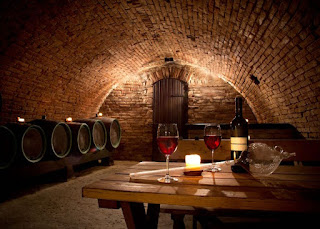 |
| Wine cellar |
Determining which wines to age needs an understanding of the three important characteristics of wine; acidity, alcohol and tannins.
Aging Red Wines
A fine red wine goes into a bottle from barrel containing a mix of tannins, pigments and all sorts of flavor compounds collectively called phenolics. Good wines have more of these properties in a balanced proportion than ordinary wine and great wines more than good wines.In the bottle tannins continue to interact with pigments and acids to form new compounds and molecules. This means as wine ages, it loses color and sharpness but gains complexity and sediment. Likewise the acids and alcohol react together with oxygen to form compounds called esters and aldehydes. The overall effect is to produce a much more delicate and complex wine.
Aging White Wines
The equivalent process in white wines is largely dependent on acidity as it tends to have lesser phenolics compared to red wines rich in tannins. These attributes tend to mellow with age into honeyed, nutty or savory complexities. Therefore white wines with higher acidity will tend to last longer and mature well if they have sufficient flavor compounds. A wine that starts with lower acidity will flatten out and lose its zest if not consumed early.Alcohol Level effect on Aging
The level of Alcohol is another important element in wine aging. Alcohol is volatile in non-fortified wines and causes wine to degrade or turn to vinegar more quickly. Generally speaking, the lower the alcohol level (12 - 14 %) in a non-fortified wine the longer it will last.Climate effect on Aging
Climate plays an important role in the tannins and acidity characteristics of a wine. So red grapes with thick skins and therefore higher tannins, typically the product of a dry climate or year, are likely to age longer than those from wet years whose skin to pulp ratio is much lower. Similarly, white wines made from grapes grown in cooler climate regions or year are likely to need longer before their acidity mellows to an acceptable level.Overall Balance
Generally speaking, the more tannins in a red wine and the more acidity in a white, the longer the wines will age. However much will also depend on the fruit flavors of the wine and the right proportion of all these attributes to create a complex and harmoniously balanced wine from further ageing in bottle.References
The World Atlas of WineArticle Category: Drinks




No comments